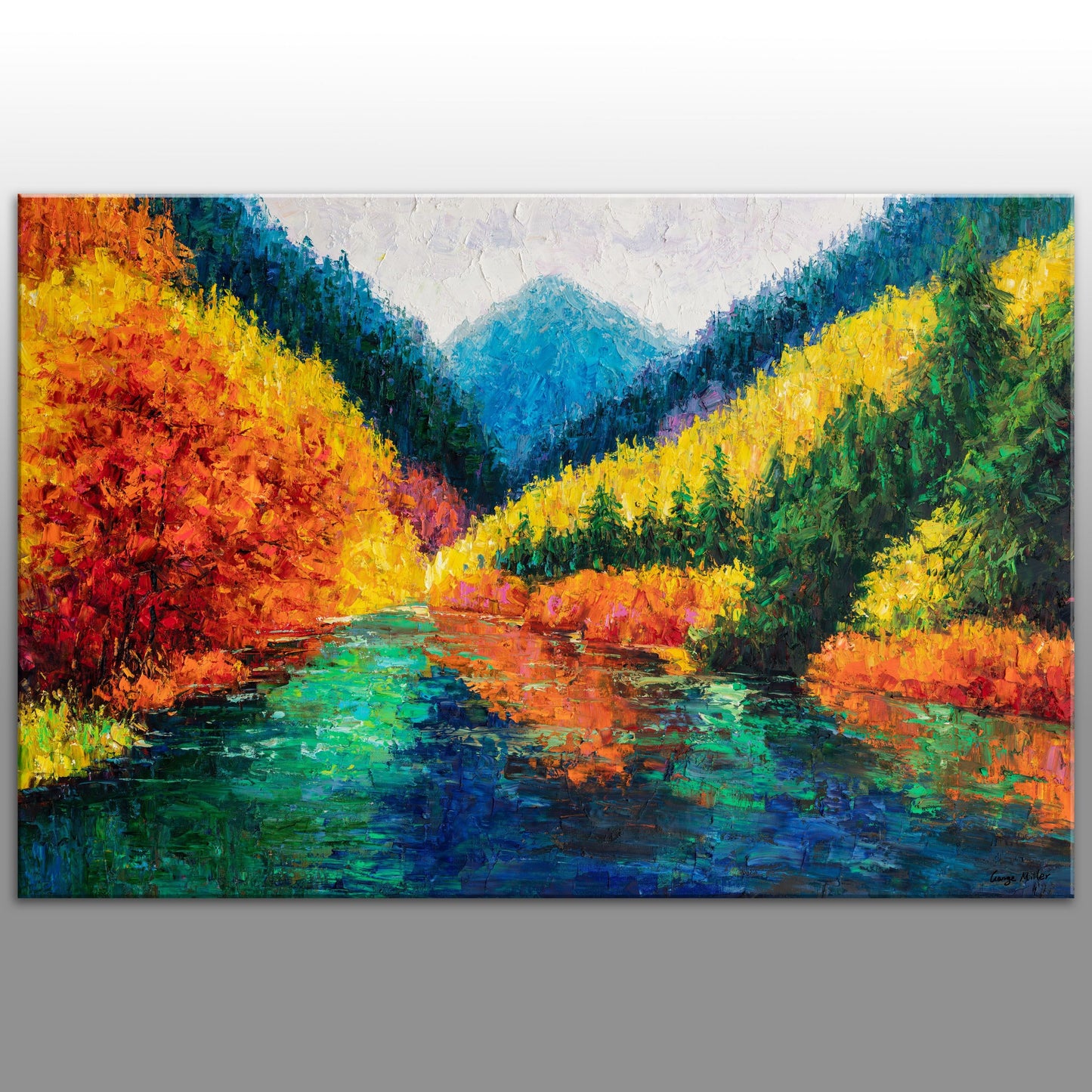Checking out Everything About Oil Paintings: A Guide to Recognizing Their Charm and Worth
Oil paintings have mesmerized audiences for centuries, providing a glimpse into the artistic mastery of various periods. Their abundant background is intertwined with innovative strategies and profound psychological expression. Understanding the materials and approaches behind these artworks can improve appreciation. In addition, the marketplace for oil paintings presents possibilities for collectors and financiers alike. As one discovers this remarkable globe, the question emerges: what makes an oil paint genuinely beneficial?
The Background of Oil Painting: A Trip Through Time
Oil paint has origins that date back to old times, it truly thrived throughout the Renaissance, when musicians discovered its convenience and rich color potential. Early instances can be traced to the 7th century, with strategies advancing especially throughout societies. The tool ended up being popular in Northern Europe in the 15th century, particularly with the jobs of artists like Jan van Eyck, that pioneered its use for thorough realism and vivid colors. This period marked a separation from tempera paints, permitting higher deepness and texture. As oil paint spread, it affected numerous artists, bring about masterpieces by prominent figures such as Leonardo da Vinci and Rembrandt. The medium's tradition proceeds, forming the art world well right into modern times.
Understanding Oil Repaints: Materials and Techniques
As musicians discover the globe of oil paints, they experience a diverse selection of products and techniques that specify this medium. The main parts of oil paint consist of pigments, which supply color, and drying oils, such as linseed, that bind the pigments and help with application. Numerous additives can modify the paint's texture and drying out time, improving flexibility. Techniques like glazing, where transparent layers are constructed up, and impasto, which involves applying thick paint, permit various aesthetic results. Furthermore, the usage of brushes, palette knives, and even fingers can create unique structures and surfaces. Understanding these products and techniques enables musicians to fully reveal their imagination and attain the preferred impact in their art work.
The Duty of Shade in Oil Paintings
Color plays a pivotal function in oil paintings, influencing both visual appeal and psychological vibration. Recognizing color theory essentials, consisting of the relationships between hues, can boost an artist's capacity to convey mood and environment. In addition, grasping color mixing techniques permits greater deepness and richness in a painting's scheme.

Shade Theory Basics
Understanding color concept is essential for musicians collaborating with oil paints, as it forms the foundation for developing unified and aesthetically appealing make-ups. Shade theory includes the research study of exactly how colors communicate, the shade wheel, and the relationships in between key, additional, and tertiary colors. Artists utilize corresponding colors to enhance contrasts and develop focal points, while similar shades advertise unity and cohesiveness within an item. In addition, the concepts of warm and cool shades affect the assumption of depth and area in a painting. Realizing these concepts allows artists to adjust shade properly, guiding the viewer's eye and communicating their intended message. Proficiency of color concept inevitably enhances a musician's capability to share feelings and ideas with their job.
Emotional Effect of Shade
The emotional influence of color in oil paints plays an important duty in just how viewers connect and perceive with art work. Shades evoke certain sensations and state of minds, affecting the visitor's emotion. Cozy tones like oranges and reds can produce a feeling of warmth and power, while cool tones such as blues and environment-friendlies commonly evoke calmness or self-contemplation. Artists purposefully pick color palettes to improve narrative elements, guiding the target market's psychological journey. The saturation and comparison of colors even more magnify these effects, drawing attention and producing focus. Eventually, the interplay of shades in oil paints not just boosts their visual allure yet likewise offers as a powerful tool for psychological expression, enhancing the customer's experience and analysis.
Shade Combining Techniques
While lots of facets of oil paint add to the total structure, mastering shade blending methods is crucial for accomplishing wanted effects and depth. Shade mixing can be come close to via different approaches, consisting of the additive and subtractive processes. Additive mixing entails integrating shades of light, while subtractive mixing depends on pigments, where colors mix to create brand-new tones. Musicians usually utilize a restricted combination to produce unified jobs, understanding the relationships in between main, additional, and tertiary shades. Techniques such as glazing and scumbling even more improve deepness and luminosity. By masterfully mixing shades, an artist can stimulate emotions, develop centerpieces, and accomplish a sense of realistic look, ultimately boosting the paint's psychological and visual effect.
Famous Oil Painters and Their Iconic Works

Famed for their mastery of color and technique, oil painters have produced a few of the most celebrated art work in history. Popular artists like Vincent van Gogh mesmerized target markets with his stirring brushwork in "Starry Night," while Claude Monet's "Impact, Sunup" laid the groundwork for Impressionism. Leonardo da Vinci's "Mona Lisa" continues to be a long-lasting sign of imaginative brilliant, showcasing his ability in capturing human expression. Rembrandt's "The Night Watch" illustrates his innovative usage of light and shadow. Various other noteworthy figures consist of Pablo Picasso, that transformed modern art with his bold trial and error in works like "Les Demoiselles d'Avignon," and Georgia O'Keeffe, whose vivid representations of blossoms and landscapes helped specify American modernism. Each artist's distinct style contributed greatly to the oil painting landscape.
How to Review the Quality of an Oil Paint
Reviewing the high quality of an oil painting entails a careful evaluation of workmanship strategies, along with an analysis of color and make-up. Observing brushwork, layering, and the application of paint can disclose the artist's skill degree. Furthermore, the interplay of shades and the general setup of elements add considerably to the painting's aesthetic value.
Assessing Workmanship Techniques
A meticulous assessment of workmanship techniques is vital for figuring out the top quality of an oil paint. Evaluators ought to first examine the application of paint; thick, distinctive brushstrokes may suggest an experienced hand, while overly consistent applications can show a lack of depth. oil paintings for sale. The layering technique is likewise important; the existence of lusters and varied density can boost brightness and intricacy. In addition, the top quality of the products used, such as the canvas and pigments, plays a considerable function in longevity and total visual. Interest to detail in aspects like sides and shifts in between shades mirrors the musician's dedication to their craft. Eventually, these strategies add to the painting's psychological influence and market worth, acting as indications of the artist's skill and intent
Analyzing Shade and Structure
While assessing the top quality of an oil paint, one have to concentrate on the interplay of shade and composition, as these components are essential to the artwork's overall influence. Shade choices can establish and evoke emotions state of mind; therefore, the musician's palette ought to be analyzed for consistency and contrast. A well-balanced make-up guides the viewer's eye and develops a feeling of unity. Musicians commonly employ techniques like the rule of thirds or leading lines to improve visual passion. Furthermore, using light and darkness can include deepness, boosting the three-dimensionality of the painting. Ultimately, an effective oil painting weds shade and composition, engaging the viewer and inviting a much deeper recognition of the musician's vision and technique.
Caring for and Preserving Oil Paintings
Proper treatment and conservation of oil paintings is important for maintaining their stability and longevity. To safeguard these artworks, it is crucial to show them far from direct sunlight, which can create fading and staining. Maintaining a steady atmosphere with controlled temperature level and humidity additional help in preventing damage. Cleaning up must be done gently making use of a soft, dry towel, preventing any harsh chemicals that might harm the paint or varnish. Regular evaluations for indications of degeneration, such as cracking or flaking, are recommended. When carrying or storing oil paintings, proper extra padding and framing are needed to stay clear of physical injury. Inevitably, attentive treatment adds to the visual appeal and value of oil paintings over time.
The Market for Oil Paints: Spending and accumulating
Recognizing the marketplace characteristics for oil paintings is crucial for capitalists and collection agencies alike. The value of these artworks is affected by different variables, including the musician's track record, historical significance, and current patterns. Collection agencies typically look for pieces that resonate directly while considering prospective gratitude in value. Galleries and auctions act as key venues for acquiring and selling, with prices rising and fall based upon demand and rarity. Buying oil paintings requires research study into the market, as well as an understanding of authenticity and provenance. In addition, arising artists might use chances for significant returns, while established names can command high prices. On the whole, a calculated method to collecting can yield both visual enjoyment and financial rewards.

Often Asked Concerns
What Are the Environmental Impacts of Oil Paint Products?
The environmental influences of oil paint materials include the launch of unpredictable organic substances (VOCs), unsafe waste generation, and source extraction for pigments. These elements add to contamination and eco-friendly destruction, raising issues amongst ecologically mindful artists and consumers.
Just How Do Various Canvases Impact Oil Paint Results?
Different canvases affect oil paint results considerably. Absorbency, texture, and surface area top quality can alter paint application, drying out times, and shade vibrancy. Artists frequently select particular canvases to accomplish desired results and improve their artistic expression.
Can Oil Paintings Be Brought Back if Damaged?
If damaged, Oil paintings can certainly be brought back. Specialist conservators use numerous techniques to fix rips, tidy surface areas, and address staining, making certain that the artwork keeps its initial charm and worth for future generations.
What Are the Indications of an Original Oil Painting?
The signs of an original oil paint include visible brush strokes, texture variations, and an uneven canvas weave (oil paintings for sale). In addition, credibility may be confirmed with provenance, signatures, and the visibility of a varnish layer distinct to oil mediums
Just How Has Innovation Influenced Modern Oil Painting Techniques?
Modern technology has considerably influenced modern oil painting techniques by presenting digital tools for planning, improved products for structure and longevity, and on-line platforms for sharing and selling art, therefore increasing musicians' creative possibilities and target market reach. Oil paint has origins that date back to old times, it really prospered during the Renaissance, when musicians discovered its flexibility and rich shade possibility. The emotional effect of shade in oil paintings plays a critical duty in how visitors regard and attach with art work. While several elements of oil paint contribute to the total composition, grasping shade blending techniques is vital for accomplishing desired effects and depth. Reviewing the top quality of an oil paint entails a careful evaluation of craftsmanship techniques, as well as an evaluation of shade and make-up. While reviewing the quality of an oil paint, one must focus on the interplay of color and oil paintings for sale structure, as these components are basic to the art work's overall influence.